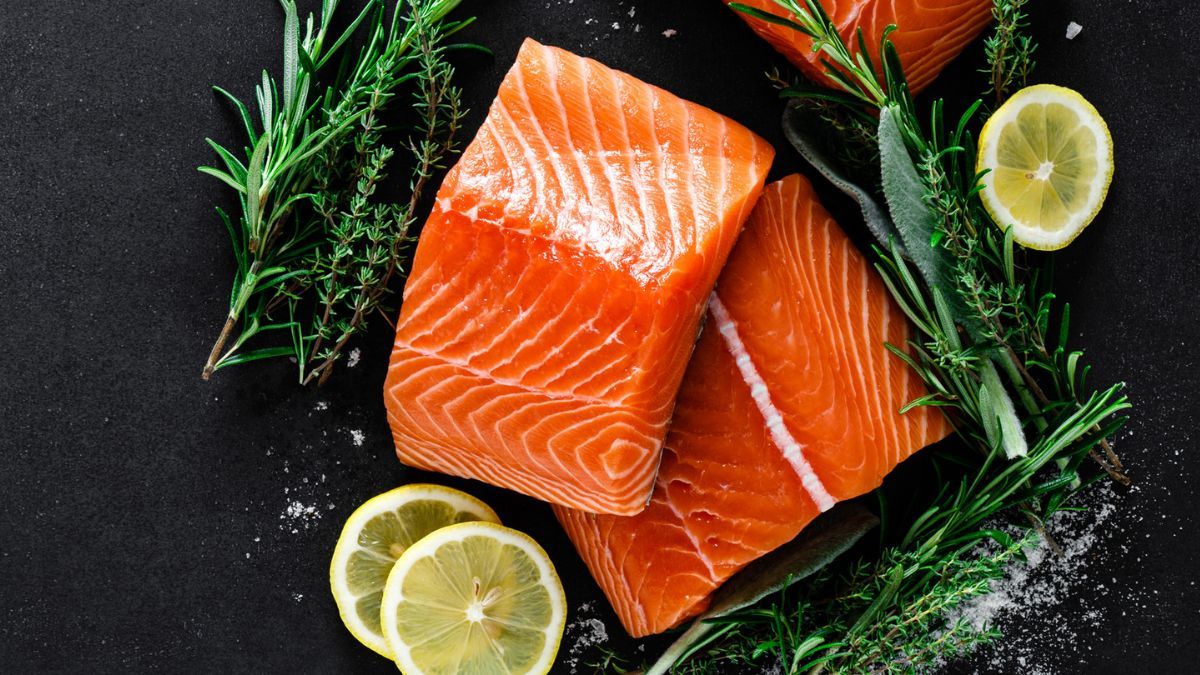To cook salmon, you need to know how to defrost it safely. There are several ways you can do this. You can defrost the fish in the refrigerator, microwave, or cold water. The best way to defrost your salmon is to keep it in a watertight bag. This will prevent bacteria from contaminating the fish.
The microwave is one of the quickest ways to defrost your frozen fish. However, it is important to note that this method can affect the texture and taste of your fish. Another way to thaw frozen salmon is to use ice. This is one of the most convenient and easy methods of thawing your salmon. However, it would be best if you changed the glaze every 15 minutes, as it will melt faster when the temperature rises.

What is Salmon?
The North Atlantic and Pacific oceans both have large populations of salmon, a particular kind of fish. It is a well-liked dietary item since it contains a lot of protein and omega-3 fatty acids. Salmon can be prepared in several ways, such as on the grill, in the oven, or by smoking.
Rivers that empty into the Pacific and North Atlantic oceans are home to salmon. These fish have mushy red-orange bodies and scaly gray-silver skin, giving them the appearance of other freshwater fish. Because it has a silky texture and is healthy, raw fish has long been seen as a pleasure in many cultures. However, not all fish can be consumed uncooked.
How to Defrost Salmon?
Depending on the length of time you have and the preferred texture of the salmon, there are a few different ways to defrost it.
- The best way to defrost salmon is in the refrigerator since it allows the fish to thaw gradually while maintaining its texture. Place the frozen salmon in the fridge and let it sit overnight to defrost.
- Put the frozen fish in a sealable plastic bag and place it in a sink full of ice-cold water. To ensure that the fish thaws evenly, change the water every 30 minutes. This process should take 30 to 60 minutes for a small fillet, and for a large one, it should take 2 to 3 hours.
- Microwave: If you need to thaw the salmon quickly, use the defrost setting on your microwave. However, using this technique can result in the fish losing some of its texture and becoming partially cooked.
It’s crucial to remember that once salmon has thawed, it needs to be cooked and eaten within two days.
What are the Different Methods of Freezing Salmon?
Salmon can be frozen using a variety of techniques to maintain its freshness and flavor:
- One of the finest ways to freeze salmon is by vacuum sealing. By eliminating the air and tightly sealing the fish, vacuum sealing prevents freezer burn and maintains the texture and flavor of the food.
- Aluminum foil or plastic wrap: Before putting the salmon in a freezer bag or container, carefully wrapping it in aluminum foil or plastic wrap can help avoid freezer burn.
- Salmon should be put in a freezer bag or container. Before sealing it, squeeze out as much air as you can.
Salmon is frozen solid using the flash freezing technique after being placed on a baking sheet and in the freezer. The fish can be moved to a freezer bag or container once frozen. This can preserve the unique fish’s texture and shape.
It’s crucial to identify the salmon with the date it was frozen, regardless of the technique, so you can track how long it has been kept. Salmon that has been frozen properly can keep for up to six months.
How to Properly Store Salmon?
There are several different storage methods depending on whether the salmon is fresh or frozen.
Fresh Salmon: You can keep the salmon in the refrigerator if you want to prepare it within two days after purchase.
To keep the salmon cold, put it in a plastic bag or container and cover it with ice or ice packs.
The bottom or back of the refrigerator is typically the coldest place to store salmon.
Salmon purchased frozen should be put in the freezer as soon as possible to preserve its quality.
Before putting the fish in a freezer bag or container, it can help vacuum seal it or tightly wrap it in plastic or aluminum foil.
Another excellent choice is the flash-freezing method.
So that you can keep track of how long the salmon has been preserved, mark the salmon with the date it was frozen.
Salmon that has been frozen properly can keep for up to six months.
It’s vital to remember that after the salmon has thawed, it needs to be cooked and eaten within two days.
What is the Taste of Salmon?
Salmon’s flavor might vary depending on the species, the habitat it lives in, and the preparation method. In general, salmon is described as having a rich, fatty flavor that is a little bit sweet and a little bit salty. Additionally, it is renowned for having a rich, moist texture that is both flaky and soft.
Fish that has been captured in the wild usually have a greater flavor than salmon that has been raised on farms. As an illustration, wild-caught Alaskan salmon tends to be darker in color and has a stronger flavor than farmed salmon. The color of the fish can also indicate its flavor. Salmon can be prepared in various ways, including grilled, baked, smoked, sashimi, and sushi.
The way the fish is cooked can also alter how it tastes. Grilling or smoking the fish will give it a smokier flavor, while sushi or sashimi will give it a fresher flavor and a slightly raw texture.
From Where can I Buy Salmon?
Depending on where you reside, there are a few different places where you can purchase fresh salmon:
- Fish markets: Fresh salmon can be found in your neighborhood fish markets. They frequently provide wild-caught and farmed salmon, among other varieties of fish.
- Supermarkets: The seafood section of many supermarkets carries fresh salmon. It is recommended to look for a “wild-caught” or “farmed” label on the box, as this can reveal the flavor and nutritional value.
- Online merchants: A few online merchants offer fresh salmon caught, prepared, and dispatched to consumers on the same day. This can guarantee the fish’s quality and freshness.
- Local fisherman: You could encounter fishermen selling their catch to customers directly in coastal locations.
- Specialist shops: Fresh salmon may be sold in some specialty shops, including gourmet markets and health food stores.
When buying fish, it’s always good to check to ensure it’s fresh. Look for eyes that are clear and shining, skin that’s wet and shiny, and no discoloration or strange odors.
Can you Eat Salmon that isn’t Cooked?
Nope. Both when it is cooked and when it is raw, salmon is generally safe to eat. What about the fish in the middle, though? Grade A danger flesh, that.
Salmon cooked on a pan is way too hot. Please boil the fish until the center registers at least 145°F (63°C). Temperatures between 40 and 140 degrees Fahrenheit are ideal for most bacteria, viruses, and other diseases (4 and 60 degrees Celsius). Your uncooked salmon in the refrigerator is likely too cold for bacteria to develop, thus. Insufficiently cooked salmon serves as a haven for insects. It’s recommended not to consume it.
How can you tell if Salmon is Bad?
There is always a slight possibility of becoming sick if you consume raw salmon. However, if you consume poor fish, this risk is substantially larger.
The good news is that you can usually differentiate rotten salmon from fresh salmon, which won’t likely give you salmonella poisoning. A few red flags are as follows:
It Has a Bad Odor
Anything else that tastes like fish should be avoided. However, when sniffing fish, you want to detect fishiness. You don’t want to smell anything akin to ammonia or skunk. Throw the fish out if you open the packaging, and the aroma makes your nose hairs curl.
Compared to other fish, the natural fishy scent of salmon is not as intense (unlike mackerel, which reeks of the sea). You may want to steer clear of the salmon if the fishy smell is too overpowering.
It Seems Grey
Salmon is reddish when it is raw; it doesn’t turn pink until it is cooked. Salmon that has become grey has expired. Salmon with a milky, slimy layer is likewise not safe to consume. If your salmon has mold or dark patches, it is similarly bad. Eat nothing that has mold on it as well.
It Doesn’t Feel Right to Be Eating Raw Salmon,
Give your fish some tender loving attention with your fingers.
Salmon is dangerous if it has a slippery texture or crumbles when touched. In contrast to shredded pork, which is slimy and sloppy, salmon should be firm and moist.
The Bad Effects of Consuming Salmon that have Gone Bad
Food poisoning brought on by eating contaminated salmon can manifest as several symptoms, such as:
- Nausea: Eating rotten seafood can make you feel sick to your stomach.
- Dehydration can result from diarrhea brought on by spoiled fish.
- Vomiting can also result from eating rotten fish.
- Bad fish might bring on stomach aches and abdominal cramps.
- Headache: Eating rotten seafood can cause headaches and other food poisoning symptoms.
- Exhaustion: A food-poisoning person may have extreme weakness and fatigue.
- Muscle pain: Affected fish may result in aches and pains in the muscles.
- Bacterial infections: Salmonella and Listeria illnesses can result from eating rotten fish.
Food poisoning can be dangerous and even deadly in difficult situations, especially for those with impaired immune systems. It’s crucial to get medical help if you believe you may have eaten tainted seafood or exhibit signs of food poisoning.
Reference: Electrical Anesthesia for Immobilizing Adult Coho Salmon in Freshwater
Without the negative effects of tricaine methanesulfonate (MS-222) or the unnecessary handling associated with physical restraint, electrical anesthesia quickly immobilized fish and facilitated sampling. Using a shocking DC basket, wild adult coho salmon Oncorhynchus kisutch that returned to spawn were sampled in freshwater. At Gehring Creek and the Chilkoot Lake weir, the coho salmon death rate attributable to the shocking basket was 0.2% and 4.2%, respectively. This is the first instance of electrical anesthesia for handling salmonids in freshwater.
Conclusion
If you plan to buy salmon, it is best to know how to refreeze salmon after defrosting. Keeping your salmon fresh will ensure you get the most out of it. Unlike other meats, fish can keep in the freezer for months. However, it is important to follow the proper procedures, so you don’t waste money and risk your health.
Defrosting salmon properly will not only make it easier to cook, but it will also help preserve the flavor and texture of the fish. There are three main methods for refreezing salmon: the refrigerator, the microwave, and the cold water bath.

